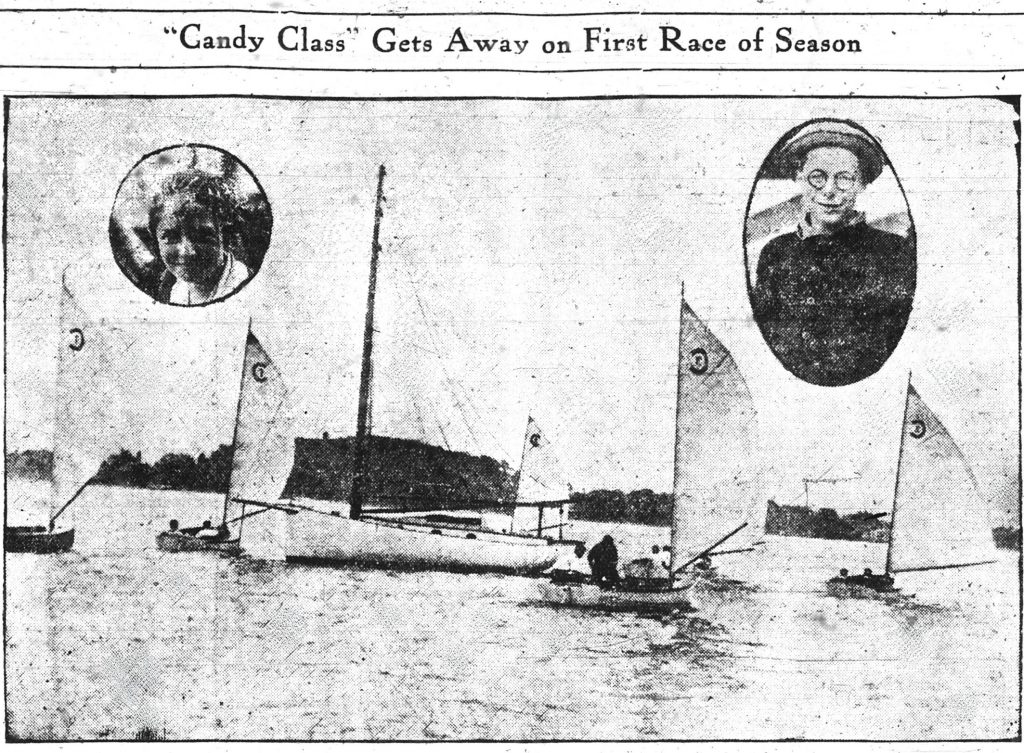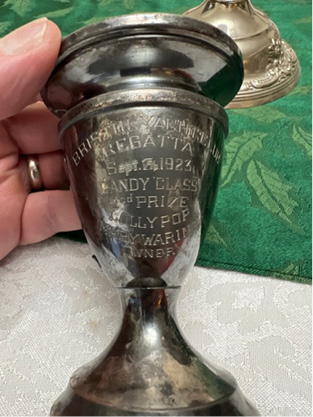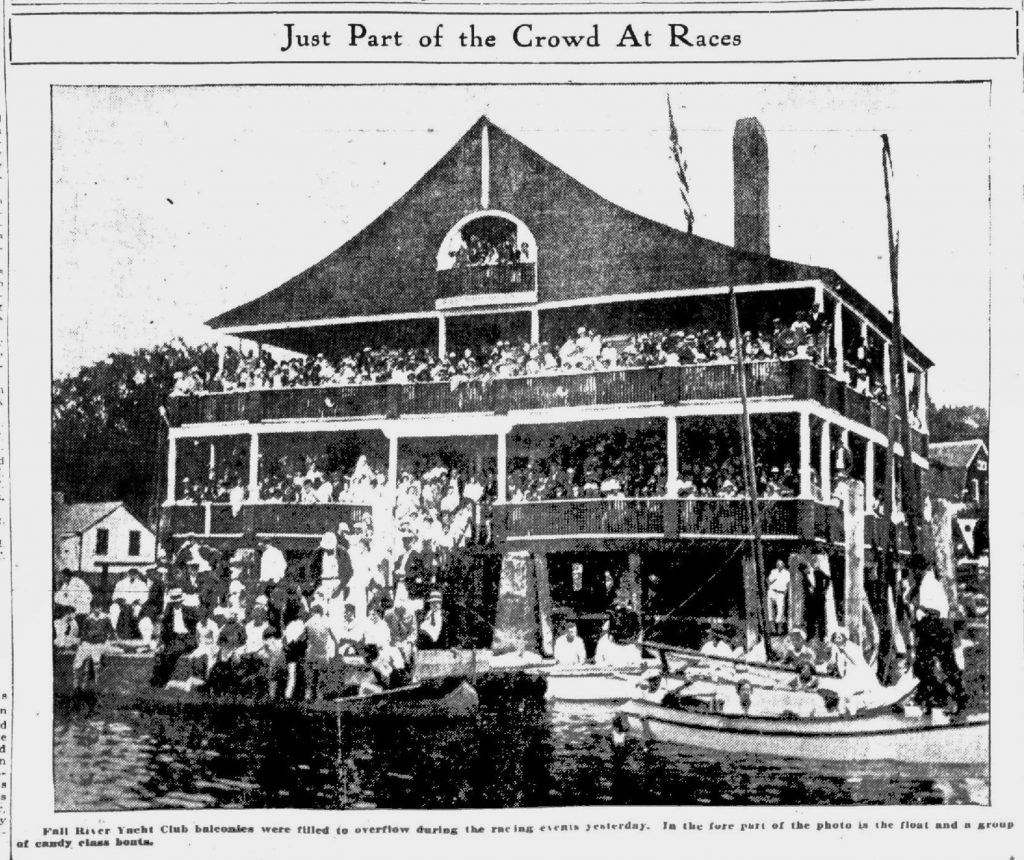The First Season: 1922
By Gail M. Martin
The first full season of racing for Candy boats was in the summer of 1922. Called the “skiff class” by The Providence Journal on April 17, 1922, “the fleet of 13 ½-foot wooden sailboats would compete on Saturday afternoons at the Tiverton Station of the Fall River Yacht Club. A series would run for eight races for trophies donated by Commodore. The first three boats in each event will receive a blue, red or white pennant depending on their finish to be flown on their headstay. And the first-place winner also gets a pound of candy.”
The June 2, 1922 Fall River Globe had a front-page article that proclaimed, “Busy Season Ahead for Fall River Yacht Club – Summer Season at Stone Bridge to be Most Enjoyable in History of the Organization.” The club would open June 22, and the Candy class races would have a triangular course in the Tiverton Basin ending at the front of the yacht club – its open-air porches providing excellent views for members and spectators. The regatta committee promised a “livelier season than has been seen in these waters in a decade.” The prophecy did not disappoint.

“Candy Class Gets Away on First Race of Season” from The Evening Herald, July 3, 1922
So even in a small one-design, competition would be fierce among the young skippers. For those whose home port was the Tiverton Basin, they might have an advantage. For to sail in the Basin meant to be skilled in observing the tides, currents and back-eddies and the wind shifts in a small body of water having unique conditions not likely replicated in other parts of Mount Hope or Narragansett Bays. At one end of the Basin was the Stone Bridge and at the other a railroad bridge that would open or close depending on boat traffic. Each area near these relatively small openings could have fierce conditions depending on the winds and the tides. Of the seven boats in the fleet, five were home ported in Tiverton and two were from Touisset (the Bordens in #2 Taffy and #3 Tootsie Roll).
The initial race of the FRYC Candy class series on July 1 was won by Harold Fawcett sailing Lifesaver. Lollypop, sailed by Seabury Waring in place of his sister, Mary Waring, (who had broken her foot) finished second. Butterscotch, sailed by H. Willard Davis, Jr., launched only a few hours before the start, finished third. The other boats and skippers were Peppermint, Harold Anthony; Gumdrop, Sanford Chace; Taffy, Doug Borden; and Tootsie Roll, J. Westall Borden.
On Saturday July 8, five boats competed in the second series. “Stiff Breeze Makes It Lively Going,” read one headline. The blustery wind was blowing from the southwest preventing the Touisset contingent from completing the trip, although the Bordens made it as far as Spar Island before turning back. Indicative of the race committee’s forbearance, the 2 pm race did not start until 3:27 pm and even then, conditions were still somewhat wild. The winner was Lifesaver, with Harold Fawcett skippering. Second was Lollypop with Seabury Waring again at the helm, and Peppermint, Gumdrop and Butterscotch finished in that order. Lifesaver with 14 points led the fleet for the Commodore’s Cup with Lollypop in second with 11.

Candy class trophy for Bristol Yacht Club regatta, September 11, 1923. Second prize: Lollypop, Mary Waring
In the next race on July 15, Lifesaver finished first and Lollypop, with Mary Waring skippering, finished second when an alleged foul occurred by Lifesaver. The result of the protest was never reported in the newspaper. Either way, it never mattered in the results for the Commodore’s Cup. The other finishers were Taffy, Tootsie Roll, and Gumdrop.
A new winner emerged on July 29 – “little Mary Waring” according to news reports. H. Willard Davis led for some of the race, but Mary slipped in and won by half a boat length. Sanford Chace in Gumdrop was third, Doug Borden in Taffy was fourth, Fawcett’s Lifesaver fifth and Jeff Borden’s Tootsie Roll last. Apparently in the aforesaid race, Clarence Wood, brother to T. Elton Wood, the Candy boat’s designer, was aboard Lollypop handling the sail as crew, and H. Willard Davis had Robert Zuill along to trim his sail. Gumdrop finished only a second behind Butterscotch.
Following this race, a meeting was held at the club due to friction among racers. The meeting results were to ban anyone over 20 years of age from racing in the Commodore Cup series. This ruling prevented the Wood brothers (of which there were four expert sailors) and Bobby Zuill, who was just above the 20-year-old age limit, from crewing for the young sailors.
The August 5 race saw a close contest. Butterscotch won and Mary Waring in Lollypop was a close second, with Gumdrop, Lifesaver, Taffy, Peppermint and Tootsie Roll finishing in that order. Butterscotch led the fleet with three more races to be sailed.
The Saturday, August 12 race saw Candies face challenging conditions. Butterscotch and H. Willard Davis with 16-year-old crew Henry Negus, Jr. won first honors. Second was Tootsie Roll, and third was Mary Waring in Lollypop, Taffy was fourth, with Gumdrop, Peppermint, and Lifesaver, finishing out the race. Good seamanship was the rule in the race as rain came steadily down all afternoon, and the wind was light. The winning boat got a pennant and a 5-pound box of candy.

Watching Candy boat racing at Fall River Yacht Club’s Tiverton station was quite popular in 1922.
Because of scheduling issues, the final race for the Commodore’s series was held after Labor Day on September 16. The wind was from the north and the contest was close, with H. Willard Davis, Jr. in Butterscotch winning, with Mary Waring’s Lollypop a close second. Taffy took third, with Gumdrop, Tootsie Roll and Lifesaver following.
Lollypop with Mary Waring captured first prize in the Commodore’s Cup by 1 point, with a total of 38. H. Willard Davis had 37, Doug Borden was third with 29. Rounding out the standings were Gumdrop, Frank Chace; Tootsie Roll, Jeff Borden; and Lifesaver, Howard Fawcett.
So, who was Mary Waring? Mary was the youngest child of George Waring who was chairman of the 1922 Fall River Yacht Club membership committee. Having a brother 10 years older and two sisters in between, she was undoubtedly facile in ‘keeping up.’ Indeed in the 1921 season, she won first prize in the 12 and under 25-yard dash swimming race at age 11. So in 1922, at the age of 12, she had the honor of being the youngest competitor in the Candy class. At times she may have had Virginia Wood, T. Elton’s daughter, as crew. But Virginia was only 14 – about the age of most of the male contestants. The other skippers would certainly outweigh her. But she had grit to withstand the blistering hot days as well as the windy and rainy ones. She had overcome the odds and come out on top in her first year of sailboat racing. Here’s a list of some of her fellow sailors and their ages: Harold Fawcett 16, H. Willard Davis 13, Howard Gibbs 14, J. Henry Negus 16, Doug Borden 15, Jeff Borden 19, and John Borden 13. Ironically, on November 5, 1922, the “Yachting Gossip” column of The Providence Journal reports that the officers of Edgewood Yacht Club are exploring introducing a skiff class like the Candies for sail training of their young sailors, noting that at Tiverton Yacht Club the youth have been outsailing the older folks in small boats. The author says, “And over at Tiverton, most of the Candy Class boys are sailing the skiffs like veterans.” Apparently, the author missed the articles about Mary Waring – her victories and the 1922 championship.
Mary Waring and Lollypop went on to race for several more years in the Candy class. A couple of years after the 1922 season, she was joined by a second female, Ruth Kerns. And after that, many more women would join the tradition of racing Candy boats. ■
This article is an excerpt from the book, Candy Class Sailboats and the Legacy of Mary Waring. You will be able to see Mary’s boat, Lollypop (No. 1), donated by Charlie Flanagan, on display in the new Wells Exhibition Hall at the Mystic Seaport Museum, to be opened in 2026. Thanks go to T. Elton’s grandson, Bill Parks, for photos of Lollypop, and Mary’s family for the photos of her trophies.
Gail M. Martin is a Candy boat historian. To learn more about her books, see newenglandmaritimepublications.weebly.com.



